We interrupt our regularly scheduled Kashgar update to bring you this late breaking news.
CARA STARTED WORK!
Cara was hired to help build the new US Embassy going up in Beijing. So far work has mostly involved meeting new people and walking around the construction sight. There are lots of Americans welding - you can tell they are not Beijingers because they wear eye protection when arc welding. Cara is currently in negotiations to be allowed to drive either the front end loader or the big red crane.
Wednesday, May 31, 2006
Tuesday, May 30, 2006
Making the most of their Mosques

 While on our many meanderings through the neighborhoods in Xinjiang, we periodically would catch sight of neighborhood mosques. What made these so intriguing is that they sit on the edge of a large cluster of mud-brick houses along tree-lined streets such that we tended to stumble upon them without warning. Most of the Uighur houses we saw were enclosed by high mud walls, with overtall entry doors that lead to small gardens that grow immediately in front of the houses themselves. These housing walls were periodically interupted by a crumbled section, a cluster of trees, or a mosque. Most unexpected on these quiet, back-lane country roads.
While on our many meanderings through the neighborhoods in Xinjiang, we periodically would catch sight of neighborhood mosques. What made these so intriguing is that they sit on the edge of a large cluster of mud-brick houses along tree-lined streets such that we tended to stumble upon them without warning. Most of the Uighur houses we saw were enclosed by high mud walls, with overtall entry doors that lead to small gardens that grow immediately in front of the houses themselves. These housing walls were periodically interupted by a crumbled section, a cluster of trees, or a mosque. Most unexpected on these quiet, back-lane country roads.Please note that in the second photo, there are Chinese characters above the entryway. They read "guan xiang si" or "closed village mosque." While it is entirely possible that this mosque is indeed closed, it would seem odd to go through the trouble of painting such a careful sign to proclaim it as such. Of particular interest is that this is written in Chinese. We did not see Chinese script in wide use around mosques in Xinjiang. If anyone out there can enlighten us as to the significance of this sign, we'd love to hear it.
Sunday, May 28, 2006
Meeting Mehmet
Outside Turpan, we passed through a small town that had an "old town" tourist trap at one end, half of which is built into a cliffside, and all of which is reminiscent of Navajo adobe dwellings, such as those found near the Grand Canyon. When we told our driver that we weren't interested in the established tourist scene, he was confused. "We want to walk along the streets where people live today," we told him, in Mandarin. Unfortunately, he was Uighur, and his Mandarin was not quite the same as ours. Communication was difficult, not least because we were clearly tourists who were telling him we didn't want to go where other tourists were.
 Eventually, we were able to make ourselves understood, and he drove us back into town and dropped us off. We had hoped that the town had a commercial hub, a street that might have a corner store or a local restaurant. If the village indeed had anything like that, it had long since been relocated to the tourist end of town. The rest of the village was purely residential with vineyards and orchards worked by locals who did not depend on the tourist trade for their survival.
Eventually, we were able to make ourselves understood, and he drove us back into town and dropped us off. We had hoped that the town had a commercial hub, a street that might have a corner store or a local restaurant. If the village indeed had anything like that, it had long since been relocated to the tourist end of town. The rest of the village was purely residential with vineyards and orchards worked by locals who did not depend on the tourist trade for their survival.
Along the way, Will found an opening in the wall alongside the road and stepped back into one of the neighborhood vineyards to take a few photos. The rest of us followed along, cameras at the ready. Within five minutes, Will had managed to meet and strike up a cordial conversation with Mehmet, a man who worked a healthy vineyard adjacent to the rear of his home. Mehmet propped his youngest son up on the wall so we could all admire the lad and so he could see a handful of foreigners. Conversation with Mehmet was even more difficult than conversation with our driver, as Mehmet spoke only broken Chinese.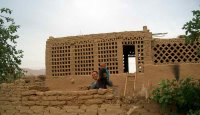 At one point in the conversation, Mehmet turned to Michael and said, "Would you like to come in and see my house?" Michael, unsure that the man had truly just invited a cluster of foreigners into his home, turned to Will for confirmation. Will shrugged, and told Mehmet that we didn't want to trouble him. The gleam in Will's eye, however, gave him away. This was precisely the sort of opportunity that we came out to find!
At one point in the conversation, Mehmet turned to Michael and said, "Would you like to come in and see my house?" Michael, unsure that the man had truly just invited a cluster of foreigners into his home, turned to Will for confirmation. Will shrugged, and told Mehmet that we didn't want to trouble him. The gleam in Will's eye, however, gave him away. This was precisely the sort of opportunity that we came out to find!
We walked around the wall that enclosed Mehmet's property and entered through the oversized gate out front, typical of Uighur residences throughout the area. Beyond the gate was a modest courtyard, most of which was occupied by two well-manicured vegetable gardens. A mud-brick walkway led us in through the open door to the main hall of his home. The main hall had a 4.5-meter/15-foot ceiling, the upper portion of which was latticed to allow breezes to ensure fresh, cool air inside the residence. The only sign of electricity within was a single 40-watt light bulb, suspended from a broomhandle that protruded from one wall.
Just past the entryway, a baby basket hung low to the floor, suspended from a rafter 4 meters (13 feet) above; with a good shove, that basket could give a kid quite a ride. Furniture was sparse: a double bed, a single cot, an end table and china cabinet, a brightly-burning clay stove, and a modest table with chairs. Most of the floorspace was open flagstone, and easily accommodated our group.
Mehmet introduced us to his wife, who brought out bowls of tea, raisins, and candies, as well as a plate of bread. It should be noted that although fresh Uighur bread is the equal of any baked good to be found in all of China, after it has had a chance to sit out and air for a while it loses any pliability it ever had. None of us was accustomed to eating hard tack like this, so it took some doing to show our appreciation for their hospitality.
Before all was said and done, Mehmet had also introduced us to his parents (who lived in the building next door) and invited us several times to stay the night at his place. Uighur generosity cannot be done justice without being experienced first-hand. For any of you who are planning trips to the Turpan area, let us know. Mehmet told us on no fewer than three occasions that we should tell our friends to stop by and take him up on his offer of dinner and lodging, particularly during the holidays.
Check back in with us here tomorrow as we share a few thoughts and photos on the neighborhood mosques.
 Eventually, we were able to make ourselves understood, and he drove us back into town and dropped us off. We had hoped that the town had a commercial hub, a street that might have a corner store or a local restaurant. If the village indeed had anything like that, it had long since been relocated to the tourist end of town. The rest of the village was purely residential with vineyards and orchards worked by locals who did not depend on the tourist trade for their survival.
Eventually, we were able to make ourselves understood, and he drove us back into town and dropped us off. We had hoped that the town had a commercial hub, a street that might have a corner store or a local restaurant. If the village indeed had anything like that, it had long since been relocated to the tourist end of town. The rest of the village was purely residential with vineyards and orchards worked by locals who did not depend on the tourist trade for their survival. Along the way, Will found an opening in the wall alongside the road and stepped back into one of the neighborhood vineyards to take a few photos. The rest of us followed along, cameras at the ready. Within five minutes, Will had managed to meet and strike up a cordial conversation with Mehmet, a man who worked a healthy vineyard adjacent to the rear of his home. Mehmet propped his youngest son up on the wall so we could all admire the lad and so he could see a handful of foreigners. Conversation with Mehmet was even more difficult than conversation with our driver, as Mehmet spoke only broken Chinese.
 At one point in the conversation, Mehmet turned to Michael and said, "Would you like to come in and see my house?" Michael, unsure that the man had truly just invited a cluster of foreigners into his home, turned to Will for confirmation. Will shrugged, and told Mehmet that we didn't want to trouble him. The gleam in Will's eye, however, gave him away. This was precisely the sort of opportunity that we came out to find!
At one point in the conversation, Mehmet turned to Michael and said, "Would you like to come in and see my house?" Michael, unsure that the man had truly just invited a cluster of foreigners into his home, turned to Will for confirmation. Will shrugged, and told Mehmet that we didn't want to trouble him. The gleam in Will's eye, however, gave him away. This was precisely the sort of opportunity that we came out to find!We walked around the wall that enclosed Mehmet's property and entered through the oversized gate out front, typical of Uighur residences throughout the area. Beyond the gate was a modest courtyard, most of which was occupied by two well-manicured vegetable gardens. A mud-brick walkway led us in through the open door to the main hall of his home. The main hall had a 4.5-meter/15-foot ceiling, the upper portion of which was latticed to allow breezes to ensure fresh, cool air inside the residence. The only sign of electricity within was a single 40-watt light bulb, suspended from a broomhandle that protruded from one wall.
Just past the entryway, a baby basket hung low to the floor, suspended from a rafter 4 meters (13 feet) above; with a good shove, that basket could give a kid quite a ride. Furniture was sparse: a double bed, a single cot, an end table and china cabinet, a brightly-burning clay stove, and a modest table with chairs. Most of the floorspace was open flagstone, and easily accommodated our group.

Mehmet introduced us to his wife, who brought out bowls of tea, raisins, and candies, as well as a plate of bread. It should be noted that although fresh Uighur bread is the equal of any baked good to be found in all of China, after it has had a chance to sit out and air for a while it loses any pliability it ever had. None of us was accustomed to eating hard tack like this, so it took some doing to show our appreciation for their hospitality.
Before all was said and done, Mehmet had also introduced us to his parents (who lived in the building next door) and invited us several times to stay the night at his place. Uighur generosity cannot be done justice without being experienced first-hand. For any of you who are planning trips to the Turpan area, let us know. Mehmet told us on no fewer than three occasions that we should tell our friends to stop by and take him up on his offer of dinner and lodging, particularly during the holidays.
Check back in with us here tomorrow as we share a few thoughts and photos on the neighborhood mosques.
Saturday, May 27, 2006
Turpan and Gaochang
Before we even had a chance to get off the bus to Turpan, a stranger accosted sat down in the midst of us and started showing Michael a pamphlet with all the things he could drive us around to see. While we were becoming somewhat more familiar with the general aggressive marketing (when we arrived in our taxis at the bus station earlier that morning, guys opened our taxi doors and started trying to make deals to drive us to Turpan), we hadn't expected it before we even got off the bus.
Although we were not taking him up on any offers, he still took it upon himself to show us how to walk to our hotel (all of 5 minutes away). We didn't think we wanted to go with this guy, so one of group members spoke up and asked, "Why are you walking with us? We have not said that we will go with you?"
We were not so into the subtle approach.
In the end, we were able to strike a deal with him and he supplied a driver and a vehicle for the entire afternoon. So apparently his marketing strategy works.
 Our first stop was Gaochang which are the ruins of an old garrison town. The outer city was once 3.4 miles long and seems huge as you walk inside. While you can still get a sense of its size, it is hard to see much of anything else there because it has been worn away with time. Michael's anthropological background came out as he noticed and commented upon building layouts, materials, and methods. He was able to draw everyone in the group into the fascinating game of, 'What do you imagine this was used for?'
Our first stop was Gaochang which are the ruins of an old garrison town. The outer city was once 3.4 miles long and seems huge as you walk inside. While you can still get a sense of its size, it is hard to see much of anything else there because it has been worn away with time. Michael's anthropological background came out as he noticed and commented upon building layouts, materials, and methods. He was able to draw everyone in the group into the fascinating game of, 'What do you imagine this was used for?'
At the other end of the ruins is a partially restored Buddhist temple. We spent quite a bit of time checking out the rest of the ruins before arriving at that end of the city, so we decided to take a donkey cart ride back to the gate to save our feet.
These ruins have been around a long time but they seemed to have become a popular tourist sight only recently and already you can see the accelerated wear taking place. The last picture shows the donkey cart road through the town and you can clearly see the wheel ruts from the cart. In some places, the ruts were almost a foot deep. You can also find all sorts of signs of recent human use in the ruins - like carving in what little plaster is left on some walls and garbage protected by the few standing walls. This lack of care of historical artifacts and sights is true throughout most of China.
The city of Gaochang is located within the Flaming Mountains which were shown in the movie "Crouching Tiger, Hidden Dragon". When these desert mountains are lit by the afternoon sun, they look as if they are (shockingly) aflame... or so we heard. We drove through the Flaming Mountains on one of Turpan's few overcast day so the mountains mostly looked like sand and stone.
We drove on from Gaochang to nearby town that was suppose to have an interesting restaurant with local wines and grapes available for weary travelers. We were all pretty excited as Chinese wine is universally terrible and the thought of some decent Chinese was intriquing. The bad news is that the information was a little too outdated to be useful and alas there was no resturant to be found. The good news was that we finally managed to communicate with our driver to the point that he understood we were looking for some experiences off the beaten path. He obligingly started driving us through some small neighborhoods and stopping the van so we could walk around, explore some backyard vineyards, and have a really wonderful afternoon. But that story if for our next blog.
Although we were not taking him up on any offers, he still took it upon himself to show us how to walk to our hotel (all of 5 minutes away). We didn't think we wanted to go with this guy, so one of group members spoke up and asked, "Why are you walking with us? We have not said that we will go with you?"
We were not so into the subtle approach.
In the end, we were able to strike a deal with him and he supplied a driver and a vehicle for the entire afternoon. So apparently his marketing strategy works.
 Our first stop was Gaochang which are the ruins of an old garrison town. The outer city was once 3.4 miles long and seems huge as you walk inside. While you can still get a sense of its size, it is hard to see much of anything else there because it has been worn away with time. Michael's anthropological background came out as he noticed and commented upon building layouts, materials, and methods. He was able to draw everyone in the group into the fascinating game of, 'What do you imagine this was used for?'
Our first stop was Gaochang which are the ruins of an old garrison town. The outer city was once 3.4 miles long and seems huge as you walk inside. While you can still get a sense of its size, it is hard to see much of anything else there because it has been worn away with time. Michael's anthropological background came out as he noticed and commented upon building layouts, materials, and methods. He was able to draw everyone in the group into the fascinating game of, 'What do you imagine this was used for?'At the other end of the ruins is a partially restored Buddhist temple. We spent quite a bit of time checking out the rest of the ruins before arriving at that end of the city, so we decided to take a donkey cart ride back to the gate to save our feet.
These ruins have been around a long time but they seemed to have become a popular tourist sight only recently and already you can see the accelerated wear taking place. The last picture shows the donkey cart road through the town and you can clearly see the wheel ruts from the cart. In some places, the ruts were almost a foot deep. You can also find all sorts of signs of recent human use in the ruins - like carving in what little plaster is left on some walls and garbage protected by the few standing walls. This lack of care of historical artifacts and sights is true throughout most of China.
The city of Gaochang is located within the Flaming Mountains which were shown in the movie "Crouching Tiger, Hidden Dragon". When these desert mountains are lit by the afternoon sun, they look as if they are (shockingly) aflame... or so we heard. We drove through the Flaming Mountains on one of Turpan's few overcast day so the mountains mostly looked like sand and stone.
We drove on from Gaochang to nearby town that was suppose to have an interesting restaurant with local wines and grapes available for weary travelers. We were all pretty excited as Chinese wine is universally terrible and the thought of some decent Chinese was intriquing. The bad news is that the information was a little too outdated to be useful and alas there was no resturant to be found. The good news was that we finally managed to communicate with our driver to the point that he understood we were looking for some experiences off the beaten path. He obligingly started driving us through some small neighborhoods and stopping the van so we could walk around, explore some backyard vineyards, and have a really wonderful afternoon. But that story if for our next blog.
Thursday, May 25, 2006
Cleaner Energy in Xinjiang

After Karakul Lake, we returned to Urumqi, then caught a bus east to Turpan. En route to Turpan, we passed by a wind farm. Although Chinese newspapers frequently tout the sundry eco-friendly projects in which the government invests, this was the first time we had been able to see the results of one of those projects. The basin in which Turpan sits is the lowest depression in all of China and much of it is unfarmable scrub and rock. It is heartening to know that the Chinese government is willing to put a few thousand windmills in such a bleak and breezy landscape. Although not particularly scenic, they conveyed a sense of pragmatism that many other Chinese engineering projects (e.g., Three Gorges Dam) seem to lack.

And if the wind farms aren't enough innovation for you, we've got another discovery. After arriving in Turpan, we chartered a private van to cart us around for the day. One of our first stops was at a gas station. A natural gas station, not a petrol station. Check out the photo.
Finally, we wished to share with you evidence of the simplest possible solution to a mechanical problem. Upon getting on our bus to Turpan, we noticed a big ol' rock sitting on the floor off to the side of the aisle. It seemed an odd piece of furniture, and none of the other passengers seemed to lay claim to it. We promptly forgot about it.
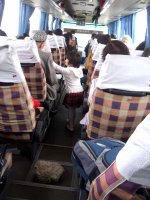 Halfway to Turpan, however, a floor hatch in the bus blew open, revealing the pavement zipping by beneath the bus. The purpose of the rock suddenly became obvious: it was the replacement for the closing latch on the hatch. Also visible in this photo is a Uighur family, with the little girl offering her grandpa a bite of the bread her mother gave her to keep her busy. At the front of the bus you will note that the television was fully operational. Instead of a bit of Chinese TV or even a movie out of Hong Kong, the film appeared to be straight from Bollywood - yet another indicator that Xinjiang is a long way from Beijing.
Halfway to Turpan, however, a floor hatch in the bus blew open, revealing the pavement zipping by beneath the bus. The purpose of the rock suddenly became obvious: it was the replacement for the closing latch on the hatch. Also visible in this photo is a Uighur family, with the little girl offering her grandpa a bite of the bread her mother gave her to keep her busy. At the front of the bus you will note that the television was fully operational. Instead of a bit of Chinese TV or even a movie out of Hong Kong, the film appeared to be straight from Bollywood - yet another indicator that Xinjiang is a long way from Beijing.Tune in tomorrow, as we take you through the ancient ruins of Gaochang....
Wednesday, May 24, 2006
Final Few Hours around Karakul Lake

Cara was the first member of the group up and about on the second morning. Venturing out with the camera, she attempted to capture hints of sunrise painted across the mountain's snowcaps. Unfortunately, the colors faded rapidly and by the time the rest of the crew poked their groggy heads out the doorflap, the day was clear and blue all around.
 The night had been wickedly cold and while yurts are mostly effective at keeping howling winds from entering, the high dome of the interior serves to wick body heat right up and out the vents at the top of the structure. Brrr!
The night had been wickedly cold and while yurts are mostly effective at keeping howling winds from entering, the high dome of the interior serves to wick body heat right up and out the vents at the top of the structure. Brrr!The chill was enough to compel Will to tie a woman's scarf around his head in a vain effort to retain a little warmth. Give that man an eye patch and he'd have made quite the convincing pirate, complete with foul-tempered curses about the weather.
Our goal for the morning was to hike out to the base of one of the nearby mountains and climb up to the snowline. From the edge of Karakul Lake, we could clearly make out glacier formations cutting between the peaks and we were hoping to see one up close.
Sadly, distances were deceptive. After two hours of steady hiking we realized that the edge of the glacier appeared no closer than it had when we first set out. We continued hiking until noon, at which point we scaled a ridge and stopped for a lunch of dried apricots, figs, raisins, and dates. The views were spectacular but too broad for our teeny camera to capture.
We'll leave you with this final image from Karakul Lake, just to show you that not every peak was shrouded in snow. Tomorrow we'll show a few indicators of China's efforts to develop clean energy alternatives that we discovered on the bus ride to Turpan.

Tuesday, May 23, 2006
You're kidding, right?
During our first day's hiking, we came across a Uighur cemetery at the side of the lake. The cemetery contained about twenty large tombs and a number of smaller grave markers. The tombs are constructed from the same mud brick-style architecture of Uighur homes in Xinjiang and often appeared to be house-shaped, with small windows allowing light and air to pass completely through the structure. No structure rose above eye level, though several topped out about there.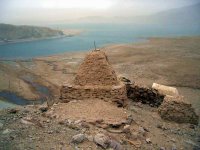 While skirting the edge of the cemetery, Michael noticed a nearby ridgeline that appeared to have a small cluster of tombs, and managed to talk Cara and Will into joining him. The climb up the ridge was somewhat arduous - in part due to the fact that our lungs were not yet acclimated to the altitude and in part due to the steepness of the rock-strewn slope, which forced us to slowly scrabble up on all fours. Upon reaching the crest of the ridgeline, we were able to get some good views of the surrounding terrain, though storm clouds were severely hampering visibility out past a mile or so. As we reached the tombs themselves, it began to hail on us. Pea-sized pebbles of ice zipped and popped off our jackets, convincing us it was time to head back to the yurt. It should be pointed out that although these tombs were typically capped by a dome and therefore looked vaguely houselike, no Uighur home we saw looked anything like them. It was like a mud-brick imitation of a yurt. In the photo, you can see a local waterway snaking its way across a largely barren landscape to empty into Karakul Lake.
While skirting the edge of the cemetery, Michael noticed a nearby ridgeline that appeared to have a small cluster of tombs, and managed to talk Cara and Will into joining him. The climb up the ridge was somewhat arduous - in part due to the fact that our lungs were not yet acclimated to the altitude and in part due to the steepness of the rock-strewn slope, which forced us to slowly scrabble up on all fours. Upon reaching the crest of the ridgeline, we were able to get some good views of the surrounding terrain, though storm clouds were severely hampering visibility out past a mile or so. As we reached the tombs themselves, it began to hail on us. Pea-sized pebbles of ice zipped and popped off our jackets, convincing us it was time to head back to the yurt. It should be pointed out that although these tombs were typically capped by a dome and therefore looked vaguely houselike, no Uighur home we saw looked anything like them. It was like a mud-brick imitation of a yurt. In the photo, you can see a local waterway snaking its way across a largely barren landscape to empty into Karakul Lake.
By the time we got back to the yurts, it was high time to use the camp's facilities. Unfortunately, the brand-new toilet facilities were locked up. A few feet away stood a corrugated steel make-shift blind, within which you could poop to your heart's content.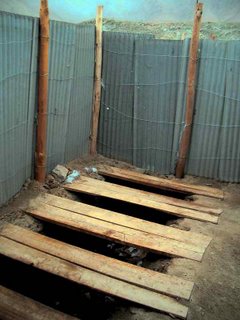
The downside was that you had to straddle a gaping mud pit, suspended above the filth by well-worn pine boards. Luckily, thanks to the thin air and ass-chapping breeze whistling down from the nearby mountain slopes, the stench of this open latrine wasn't terribly punishing. Even so, it was hardly a sanctuary. On the plus side, each latrine (one for the lads, one for the ladies) was clearly designed to simultaneously accommodate either four or eight squatters, depending on how friendly you all were.
That evening we hung out in the mess hall overlooking our yurts and met up with some interesting folks. In a "small world" moment, Yeenyee (one of our fellow adventurers) ran into someone she used to know in Singapore. Stay tuned, as tomorrow we will show you the interior of our (very humble) yurt dwellings, along with an image or two of the landscape surrounding Karakul Lake after sunrise.
 While skirting the edge of the cemetery, Michael noticed a nearby ridgeline that appeared to have a small cluster of tombs, and managed to talk Cara and Will into joining him. The climb up the ridge was somewhat arduous - in part due to the fact that our lungs were not yet acclimated to the altitude and in part due to the steepness of the rock-strewn slope, which forced us to slowly scrabble up on all fours. Upon reaching the crest of the ridgeline, we were able to get some good views of the surrounding terrain, though storm clouds were severely hampering visibility out past a mile or so. As we reached the tombs themselves, it began to hail on us. Pea-sized pebbles of ice zipped and popped off our jackets, convincing us it was time to head back to the yurt. It should be pointed out that although these tombs were typically capped by a dome and therefore looked vaguely houselike, no Uighur home we saw looked anything like them. It was like a mud-brick imitation of a yurt. In the photo, you can see a local waterway snaking its way across a largely barren landscape to empty into Karakul Lake.
While skirting the edge of the cemetery, Michael noticed a nearby ridgeline that appeared to have a small cluster of tombs, and managed to talk Cara and Will into joining him. The climb up the ridge was somewhat arduous - in part due to the fact that our lungs were not yet acclimated to the altitude and in part due to the steepness of the rock-strewn slope, which forced us to slowly scrabble up on all fours. Upon reaching the crest of the ridgeline, we were able to get some good views of the surrounding terrain, though storm clouds were severely hampering visibility out past a mile or so. As we reached the tombs themselves, it began to hail on us. Pea-sized pebbles of ice zipped and popped off our jackets, convincing us it was time to head back to the yurt. It should be pointed out that although these tombs were typically capped by a dome and therefore looked vaguely houselike, no Uighur home we saw looked anything like them. It was like a mud-brick imitation of a yurt. In the photo, you can see a local waterway snaking its way across a largely barren landscape to empty into Karakul Lake. By the time we got back to the yurts, it was high time to use the camp's facilities. Unfortunately, the brand-new toilet facilities were locked up. A few feet away stood a corrugated steel make-shift blind, within which you could poop to your heart's content.

The downside was that you had to straddle a gaping mud pit, suspended above the filth by well-worn pine boards. Luckily, thanks to the thin air and ass-chapping breeze whistling down from the nearby mountain slopes, the stench of this open latrine wasn't terribly punishing. Even so, it was hardly a sanctuary. On the plus side, each latrine (one for the lads, one for the ladies) was clearly designed to simultaneously accommodate either four or eight squatters, depending on how friendly you all were.
That evening we hung out in the mess hall overlooking our yurts and met up with some interesting folks. In a "small world" moment, Yeenyee (one of our fellow adventurers) ran into someone she used to know in Singapore. Stay tuned, as tomorrow we will show you the interior of our (very humble) yurt dwellings, along with an image or two of the landscape surrounding Karakul Lake after sunrise.
Monday, May 22, 2006
Flirting with Yurts

We left Kashgar on a Monday morning, and our destination - just shy of China's border with Tajikistan - was a place called Karakul Lake. The ride out to Karakul was arduous and not remotely fun at all. The road is under significant reconstruction at various points, requiring our driver to hack it out across rough gravel and dirt track off-and-on for the final third of the journey. Upon arriving, we were greeted with a mass of Chinese day-trippers (who all disappeared long before sunset, leaving a handful of foreign tourists to enjoy the evening together) and crude facilities that included a ramshackle restaurant, a half-dozen yurts, and a hole dug in the dirt to serve as our communal toilet. This first photo was taken from inside our yurt at the lovely view. In the background, a light snowstorm is occluding Muztagh Ata, one of the tallest mountains in China.
At over 7,500 meters above sea level, the tip of Muztagh Ata

pushes up through the cold sky above Karakul Lake. The lake itself sits around 3,600 meters above sea level. Definitely high enough to cause altitude sickness, from which Olivia suffered immediately upon our arrival. Michael grew ill halfway through our second day at Karakul, though it is unclear whether it was truly altitude-related, as he remained ill well after after returning to the relative lowlands of Kashgar.
Although we experienced brief periods of cloudy/overcast/nasty weather, when the clouds finally blew away the sky was so clear that during late afternoon, if you looked directly up, the blueness of the sky had a night-time darkness to it that was a little eerie. It sure made for some vivid-blue photos, though!

This last photo was taken at about 10pm, Beijing time; sunset at Karakul Lake. We took a lot of pictures while out and about at Karakul, and it is truly an awe-inspiring location to visit. Stay tuned, as tomorrow we will share with you a few of the more surprising sights during our stay at Karakul Lake.
Friday, May 19, 2006
Our New Friends
Everyone knows that the pen is mightier than the sword, but we are here to tell you that a pencil will do in a pinch.
When we were at the noodle place for lunch in the Kashgar lamb market, the 3 kids at the lunch place somehow made it clear that they were very interested in the writing utensils stuck into the tactical loops on the outside of Michael's CamelBak. The Bic pen was a huge success while the mechanical pencil was deemed acceptable though somewhat less exciting as it was unable to write on the arm of the particular child who was testing it out.
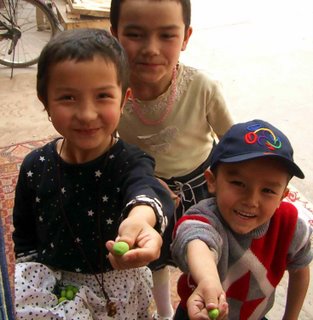 But our favorite interaction with the local children was with this bunch. While some of our party was inside a rug shop, we decided to wait out front and watch the world go by. These three were walking/skipping/running down the street and upon seeing us, they yelled out the one word of English that every child we met knew. "Hello!" Then they all started giggling at their own brashness. At the same time they were all holding onto large handfuls of something and happily munching away. You can see how their ring-leader in the black top was using her skirt as the major snack receptacle. Seizing her moment, Cara asked them a question in Chinese, "What are you eating?" Although it is quite likely they didn't understand because
But our favorite interaction with the local children was with this bunch. While some of our party was inside a rug shop, we decided to wait out front and watch the world go by. These three were walking/skipping/running down the street and upon seeing us, they yelled out the one word of English that every child we met knew. "Hello!" Then they all started giggling at their own brashness. At the same time they were all holding onto large handfuls of something and happily munching away. You can see how their ring-leader in the black top was using her skirt as the major snack receptacle. Seizing her moment, Cara asked them a question in Chinese, "What are you eating?" Although it is quite likely they didn't understand because
1) Cara's Beijing accent is radically different then the Mandarin spoken in Kashgar (and possibly different from the Mandarin spoken anywhere else in China), and
2) They probably didn't speak Mandarin (Uighur children, in general, only spoke Uighur in our presence)
Regardless, they immediately came over to us and offered the fruits they were enjoying so much. No questions, no hesitation, just an exuberant look on the face that declared 'here try this - its great!' Much to our chagrin, we saw that the things they were eating looked suspiciously like (as in identical) some other fluorescent green fruits we had bought and tried back in Beijing. Those had turned out to be fresh olives and they tasted absolutely awful. So bad in fact that we even threw out the initial testing bites as well as the rest of the fruits. And here these friendly little kids were offering us the same thing. Uh oh. But we couldn't deny their happy faces so we each took a glowing green olive and gave it a little bite preparing for the worst. But.. it was ...good?! We have since learned that there are two different olive types, one is round and one is oval. As subtle as difference sounds, it makes a huge difference in taste.
So thanks to our new friends, we had yet another new treat in Kashgar.
When we were at the noodle place for lunch in the Kashgar lamb market, the 3 kids at the lunch place somehow made it clear that they were very interested in the writing utensils stuck into the tactical loops on the outside of Michael's CamelBak. The Bic pen was a huge success while the mechanical pencil was deemed acceptable though somewhat less exciting as it was unable to write on the arm of the particular child who was testing it out.
 But our favorite interaction with the local children was with this bunch. While some of our party was inside a rug shop, we decided to wait out front and watch the world go by. These three were walking/skipping/running down the street and upon seeing us, they yelled out the one word of English that every child we met knew. "Hello!" Then they all started giggling at their own brashness. At the same time they were all holding onto large handfuls of something and happily munching away. You can see how their ring-leader in the black top was using her skirt as the major snack receptacle. Seizing her moment, Cara asked them a question in Chinese, "What are you eating?" Although it is quite likely they didn't understand because
But our favorite interaction with the local children was with this bunch. While some of our party was inside a rug shop, we decided to wait out front and watch the world go by. These three were walking/skipping/running down the street and upon seeing us, they yelled out the one word of English that every child we met knew. "Hello!" Then they all started giggling at their own brashness. At the same time they were all holding onto large handfuls of something and happily munching away. You can see how their ring-leader in the black top was using her skirt as the major snack receptacle. Seizing her moment, Cara asked them a question in Chinese, "What are you eating?" Although it is quite likely they didn't understand because1) Cara's Beijing accent is radically different then the Mandarin spoken in Kashgar (and possibly different from the Mandarin spoken anywhere else in China), and
2) They probably didn't speak Mandarin (Uighur children, in general, only spoke Uighur in our presence)
Regardless, they immediately came over to us and offered the fruits they were enjoying so much. No questions, no hesitation, just an exuberant look on the face that declared 'here try this - its great!' Much to our chagrin, we saw that the things they were eating looked suspiciously like (as in identical) some other fluorescent green fruits we had bought and tried back in Beijing. Those had turned out to be fresh olives and they tasted absolutely awful. So bad in fact that we even threw out the initial testing bites as well as the rest of the fruits. And here these friendly little kids were offering us the same thing. Uh oh. But we couldn't deny their happy faces so we each took a glowing green olive and gave it a little bite preparing for the worst. But.. it was ...good?! We have since learned that there are two different olive types, one is round and one is oval. As subtle as difference sounds, it makes a huge difference in taste.
So thanks to our new friends, we had yet another new treat in Kashgar.
Thursday, May 18, 2006
Children as Court Jesters
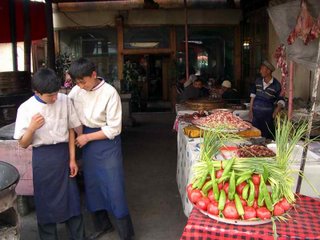
Throughout our travels in Xinjiang, we took every possible opportunity to walk the streets and get a personal feel for life in the region. Kashgar teemed with young children, screaming with laughter, using squirt guns in the dusty alleyways and converting concrete ramps into makeshift slides. They adored foreigners and were especially happy to pose for photographs. Nowhere in Beijing will you find such wanton pursuit of harmless fun, and it was infectious.
 Sadly, we did not capture any of the frolicking on camera, though the two photos provided with this posting show a few characteristics of Kashgari neighborhoods: first, children are an active part of the economy, but still find ways to be children even on the job; second, they manage to find joy in living conditions that otherwise are less than inspiring. Mud-brick homes lean heavily against one another, with wooden ladders leading from one ancient-looking level to the next. Only the vibrant fabrics in which Uighur women dress themselves add color to the browns everywhere else. The glee of the Uighur children transformed this ordinarily impoverished landscape into a warm, happy place, one that imparts a sense of community, security, and contentment. A stark difference from daily scenes in Beijing, we can assure you.
Sadly, we did not capture any of the frolicking on camera, though the two photos provided with this posting show a few characteristics of Kashgari neighborhoods: first, children are an active part of the economy, but still find ways to be children even on the job; second, they manage to find joy in living conditions that otherwise are less than inspiring. Mud-brick homes lean heavily against one another, with wooden ladders leading from one ancient-looking level to the next. Only the vibrant fabrics in which Uighur women dress themselves add color to the browns everywhere else. The glee of the Uighur children transformed this ordinarily impoverished landscape into a warm, happy place, one that imparts a sense of community, security, and contentment. A stark difference from daily scenes in Beijing, we can assure you.
Wednesday, May 17, 2006
All in the Family
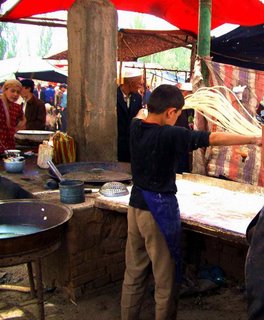
As the early afternoon wore on, a few of our bellies began to grumble and we made our way to the far end of the bazaar where a row of outdoor restaurants sidled next to one another. Each one was selling more or less the same thing: lamb with noodles. We chose a place within sight of a local ice-cream maker (the kind that rely on a wooden barrel and an external motor to stir the cream with ice and sugar) and a butcher stand. The tables and benches were rickety, and the bowls in which we were served still had crusty bits of food from the previous diners, but we were hungry and willing to take our chances.
 As near as we could tell, a single Uighur family operated this stall. There were two grown men and three children. The two men tended mostly to the noodles and the lamb soup. The oldest child, a girl perhaps 10 or 12 years old, prepared all the vegetables. The youngest child, a boy of about 6 or 7 years of age, washed the dishes (hence the bits of leftover grunge on the bowls). The middle child appeared to have the most variety in his duties, popping between the two men to learn by mimicry. In these photos, you can see the middle child making Xinjiang-style noodles, where the noodle dough is rolled into a ball, pulled apart, and then whipped about in a mostly graceful manner that stretches the dough into long tendrils. That dirty brick structure to the left of the noodle kid is their stove. Set into the stove is a largish wok with a lid, beneath which simmers a starchy broth. Once the kid finishes with the noodles, they are tossed into the steaming broth to cook, then moved to the standing bowl of liquid adjacent to the stove to stop the cooking process before serving the noodles to customers. After combining with lamb and vegetables, it made for a cheap yet filling and tasty meal, dirty dishes notwithstanding. The photo with the two bowls and the ballcap-bedecked boy is the dishwashing station. Unsurprisingly, they don't have running water to flush out the wash basins. It should be noted that none of us took ill as a result of this meal, believe it or not.
As near as we could tell, a single Uighur family operated this stall. There were two grown men and three children. The two men tended mostly to the noodles and the lamb soup. The oldest child, a girl perhaps 10 or 12 years old, prepared all the vegetables. The youngest child, a boy of about 6 or 7 years of age, washed the dishes (hence the bits of leftover grunge on the bowls). The middle child appeared to have the most variety in his duties, popping between the two men to learn by mimicry. In these photos, you can see the middle child making Xinjiang-style noodles, where the noodle dough is rolled into a ball, pulled apart, and then whipped about in a mostly graceful manner that stretches the dough into long tendrils. That dirty brick structure to the left of the noodle kid is their stove. Set into the stove is a largish wok with a lid, beneath which simmers a starchy broth. Once the kid finishes with the noodles, they are tossed into the steaming broth to cook, then moved to the standing bowl of liquid adjacent to the stove to stop the cooking process before serving the noodles to customers. After combining with lamb and vegetables, it made for a cheap yet filling and tasty meal, dirty dishes notwithstanding. The photo with the two bowls and the ballcap-bedecked boy is the dishwashing station. Unsurprisingly, they don't have running water to flush out the wash basins. It should be noted that none of us took ill as a result of this meal, believe it or not.
Tuesday, May 16, 2006
The Bizarre Bazaar of Kashgar

So you wanna buy a camel? How about two? Well, you came to the right place! Our small group of intrepid tourists departed Kashgar's main bazaar on the backs of motorcycles that had been converted into transports (on our way back into town, we managed to get six people on the back of one of these contraptions!). Apparently, this type of private transport is only marginally legal in Kashgar. Within minutes of climbing aboard, we were told to hop off quickly, as there was a police vehicle across the street. So we got off and walked alongside the one-cylinder trikes for about a block before being told the coast was clear and we could re-mount safely.
 Upon finally reaching the "old" bazaar, we were able to see what all the fuss was about. There were hundreds upon hundreds of sheep for sale, plus a number of cattle and goats, and even some camels, as the leading photo indicates. What caught us completely by surprise, however, was that Kashgari sheep have big ol' butts. That is to say, they have an "extra" butt perched atop their more natural, sheep-like butt. Although one could speculate quite inventively as to the purpose of such an appendage, in local use it was clear that these extra cheeks were lumps of fatty tissue that, during butchering, provided the chef with a large quantity of cooking fat. Mmmmm. All right, so it tasted more like gristle than yummy lamb goodness, but the locals seemed to really dig it, so who were we to turn up our noses?
Upon finally reaching the "old" bazaar, we were able to see what all the fuss was about. There were hundreds upon hundreds of sheep for sale, plus a number of cattle and goats, and even some camels, as the leading photo indicates. What caught us completely by surprise, however, was that Kashgari sheep have big ol' butts. That is to say, they have an "extra" butt perched atop their more natural, sheep-like butt. Although one could speculate quite inventively as to the purpose of such an appendage, in local use it was clear that these extra cheeks were lumps of fatty tissue that, during butchering, provided the chef with a large quantity of cooking fat. Mmmmm. All right, so it tasted more like gristle than yummy lamb goodness, but the locals seemed to really dig it, so who were we to turn up our noses?The livestock bazaar was a festive place, with hundreds of sellers and buyers along with a scattering of tourists (sellers and buyers didn't bring cameras, making our fellow interlopers easy to identify, few though they were) all poking and prodding verious parts of slightly uneasy sheep. Routine inspections included what looked to Michael suspiciously like a proctology examination, if a little quickly delivered and without the benefit of latex gloves, vaseline, or a table to clutch onto. We would have lamented the indignity on the sheep's behalf, but please consider that this examination was very likely to be the high point of their day. Poor sheep.
Regardless, the sheep could be bought, shorn, butchered, and cooked right there at the bazaar. Stay tuned, as tomorrow's blog entry will reveal our lunch at this bustling livestock supermarket!
Monday, May 15, 2006
Next Stop: Kashgar

We woke the next morning in the ancient trade center, Kashgar. The photo above shows the view from our hotel window. On the right side of the photo you can see the twin minarets of the Id Kah Mosque, nestled among the houses and shops at the eastern end of "old town" Kashgar. This area is where the local Uighurs live in traditional mud-and-straw brick homes. The Id Kah Mosque is the largest mosque in China, and it sits on a site that has been the religious center for Kashgari Muslims since the 15th Century.

What separates Kashgar from other cities in China is not just the traditional mud-brick architecture of the homes, and not the madcap bazaar every Sunday, and not the silly statue of Chairman Mao hailing a cab in the city center; it's the open warmth of the people. Uighurs are among the friendliest people we've ever met. They were consistently generous, kind, and exuded a sense of comfort with their place in the universe. It was startling how much we had taken the high-stress and somber demeanor of northeastern China for granted.
 By escaping to the more remote areas of the west, we were able to immerse ourselves in a lively society of people who are destitute only in terms of modern finance; in terms of family, the laughter of children, good food, and humbling landscapes, they are immeasurably wealthy. And they know it.
By escaping to the more remote areas of the west, we were able to immerse ourselves in a lively society of people who are destitute only in terms of modern finance; in terms of family, the laughter of children, good food, and humbling landscapes, they are immeasurably wealthy. And they know it.Tune in tomorrow as we share with you the chaos of Kashgar's Sunday Bazaar, an event that draws an estimated fifty thousand visitors to Kashgar every week. Don't miss it!
Saturday, May 13, 2006
Stopover in Urumqi
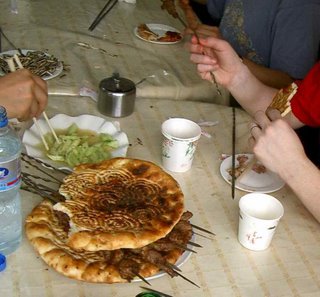
The first leg of our journey took us via plane from Beijing to Kashgar, with a few hours spent at Urumqi in between. Urumqi is the capital city of Xinjiang Uighur Autonomous Region (hereafter refered to as "Xinjiang") and Kashgar is an ancient market nexus on the very fringe of China. The food visible in the photo above consists of some Xinjiang stand-byes: lamb kabobs and flatbread. The bread is similar to Indian naan bread and in baked in a ceramic oven that closely resembles an Indian tandoor. Unlike Indian naan, Uighur naan is a bit chewier and tougher. The taste is similar to a plain pizza crust. The most common assemblage of lamb kabobs we ingested while in Xinjiang consisted of a series of spicy lamb meat bits in between pieces of lamb fat/gristle (for flavor, we presumed). They were fresh-grilled goodness, with bits of char and red pepper to bring out the best in grilled lamb.
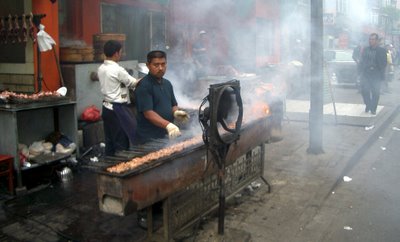
This photo shows a typical kabob grilling trough in Urumqi, though the fan in front of the trough (used by this vendor to waft the mouthwatering grillsmoke across the street to attract customers) was unusual. At the far end of the trough is a charcoal chimney, where the coals are stacked and burned before being raked across the length of the trough. Dozens of metal skewers, laden with lamb and spice and fat, are laid across the maw of the trough and grilled to smokey perfection before being sold for pennies to passers-by. Behind the grillmeister, you can see kabobs in-the-raw, awaiting their time to move to the grill.
Friday, May 12, 2006
Xinjiang Dried Fruit
One thing this province is known for is its dried fruit. And by dried fruit, we mean raisins. LOTS and LOTS of raisins. They come in pale green, dark green, every shade imaginable between light red, brown, and black, and of course fluorescent orange. (Don't eat the fluorescent orange ones by the way - they are not very nice at all.) They also come in everything from little tiny dried ones to huge fat plump ones. After extensive taste testing everyone agreed that the hand-picked big plump green ones from the vendor outside of the Turpan bus station were the absolute best raisins ever. They were also 40 kuai a jin = $5 US/0.5kg which was a little pricey, but ohhh so good.
Despite having a different vendor at every street corner selling this amazing variety of really incredibly yummy raisin, it was with great restraint that we managed to come home with only 4kg worth.
We think they might stretch to last the month if we're careful.
Despite having a different vendor at every street corner selling this amazing variety of really incredibly yummy raisin, it was with great restraint that we managed to come home with only 4kg worth.
We think they might stretch to last the month if we're careful.
Thursday, May 11, 2006
The Hiatus is over: prepare for the Xinjiang Travel Log

Just sit right back and you'll hear a tale,
A tale of a fateful trip
That started from this hectic port
Aboard this tiny ship.
The mate was a mighty blogger man,
The skipper brave and sure.
Six passengers set sail that day
For a twelve day tour,
a twelve day tour.
The weather started getting rough,
The tiny yurt was frost,
If not for the huddling of the fearless crew
Our poor toes would be lost,
our poor toes would be lost.
With good luck and some medicine we survived our trial,
With William
And Olivia too,
The diplomat and his wife,
The billing star
The solicitor and all their gear,
Here in Xinjiang Uighur Autonomous Region!
Dang. That last part doesn't flow very well.
Regardless, we know that in our absence the blog has gotten a little old, and we're back to liven things up again! Over the coming posts, we are going to share our experiences traveling to the far west of China, a mostly barren chunk of rock known as Xinjiang Uighur Autonomous Region.
This first photo was taken during a late afternoon stroll through the twisting streets of Kashgar as a stormcloud rolled overhead. From left to right: Cara, YeenYee, Olivia, and Will. Waifang is walking directly in front of Cara but is not particularly visible (she is wee). Michael is out of frame because he was hiding behind the camera.
Subscribe to:
Posts (Atom)

